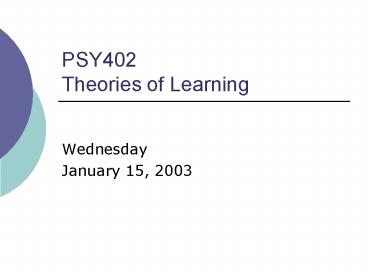PSY402 Theories of Learning - PowerPoint PPT Presentation
1 / 15
Title:
PSY402 Theories of Learning
Description:
PSY402 Theories of Learning Wednesday January 15, 2003 Examples of Conditioning Popcorn at the movies. Fear of flying -- stronger with more turbulence (a stronger UCS). – PowerPoint PPT presentation
Number of Views:75
Avg rating:3.0/5.0
Title: PSY402 Theories of Learning
1
PSY402Theories of Learning
- Wednesday
- January 15, 2003
2
Examples of Conditioning
- Popcorn at the movies.
- Fear of flying -- stronger with more turbulence
(a stronger UCS). - An antelope shying away from low tree branches.
- Nausea at the smell of alcohol after a hangover.
3
Conditioning Situations
- Sign-tracking (autoshaping) animals must
recognize signs of food (UCS) and respond (UCR). - Pigeons pecking at key.
- UCR, not an operant response, because behavior is
specific to the stimulus. - Eyeblink conditioning
- UCR is rapid, CR is slow.
- Many trials are needed (100 pairings)
4
Fear Conditioning
- Avoidance is not a good measure of fear.
- Suppression of an operant behavior occurs with a
feared stimulus. - First an operant behavior is learned.
- Second a CS is paired with an aversive UCS.
- Third the CS is presented in the operant
chamber.
5
Suppression Ratio
- During CS
- SuppressionRatio During CS Without CS
- The amount of time during and without the CS is
equal. - The more fear, the lower the suppression ratio.
- Ratios typically fall between 0 and .5
6
Flavor Aversion Learning
- Garcia rats will not drink water with saccharin
if they get ill after drinking. - Significant avoidance occurs after just one
trial. - Human food aversions are related to illness
(89). - Even if illness occurs hours later it is linked
to the previous meal. - Not cognitive know food not to blame
7
Conditioning Paradigms
- Delayed conditioning the CS onset precedes the
UCS onset. - Trace conditioning the CS starts and ends
before the UCS onset. - Simultaneous conditioning the CS and UCS occur
together. - Backward conditioning the UCS starts and ends
before the CS onset.
8
Temporal Conditioning
- No CS is presented.
- The UCS occurs at regular intervals.
- A CR eventually occurs just before the UCS.
- Mechanism a biological state typically provides
the CS. - Waking up just before the alarm goes off.
9
Importance of Timing
- A cue (CS) needs to be a good predictor of the
UCS. - Optimal inter-stimulus-interval (ISI) varies with
the kind of response. - The latency to respond is different for different
reflexes (saliva, heart rate) - Too long or too short intervals result in weaker
conditioning. - Intermediate CSs form a bridge.
10
Importance of CS Strength
- CS intensity affects CR strength only when the CS
intensity varies. - If the CS strength is always the same, then the
CS strength doesnt affect the size of the CR. - Both dogs must bite in order for their size to
matter. - In order for CS intensity to matter, it must
signal something.
11
Importance of UCS Strength
- Strength of the CR increases with strength of the
UCS. - The more intense the air puff, the stronger the
eyeblink CR.
12
Salience of the CS
- Salience refers to how noticeable a stimulus is
how likely an organism is to notice it in the
environment. - Preparedness (evolutionary predisposition) makes
some CS more salient than others. - The more salient the CS, the stronger the CR and
faster learning.
13
Predictiveness of the CS
- Predictiveness refers to how reliably the CS is
associated with the UCS. - When two or more CSs are present, only the most
reliable elicits a CR. - When the CS occurs with the UCS more often than
the UCS occurs alone, conditioning occurs. - A CS alone weakens conditioning.
14
Blocking
- Presence of a previously conditioned CS (existing
predictive cue) prevents conditioning of a new
CS. - Parent threats presence of fear of the parent
prevents acquisition of fear to another stimulus.
15
Implications for Parenting
- Threats (CS) should reliably be accompanied by
punishment (UCS) or they will be ignored. - Timing of threat (CS) and punishment (UCS) should
be close together not wait until Dad gets home. - Fear of parents (CER) may block conditioning of
any other CS.































